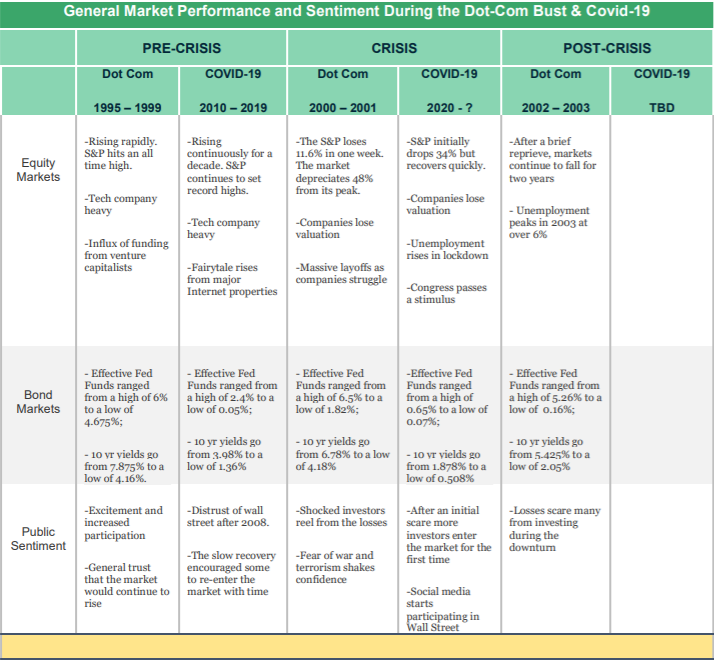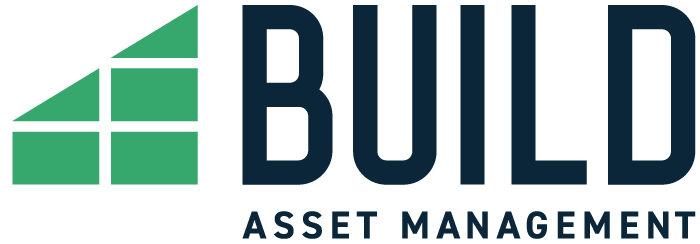Markets are unpredictable. So how do we prepare for the worst? Or the best?
Stock market crashes leave lasting impressions on investors. The sudden panic when faced with a major loss is all too familiar for those who lived through events such as Black Monday in 1987, the dot-com crash in 2000, the 2008 crash stoked by the Global Financial Crisis, and the crash of early 2020 caused by the COVID-19 pandemic. 1987, 2000, and 2008 all marked the beginning of nasty bear markets and global recessions, so in the case of the 2020 crash investors could be forgiven for drawing the conclusion that we were facing a long road to recovery. Surely the rapid spread of a novel and deadly virus coupled with a global economic shutdown was the catalyst needed to bring an end to the current decade-long equity market bull run.
However, investors who drew this conclusion and pulled money out of the market in February and March of 2020 would have lost out on the rapid “v-shaped” stock market recovery that followed. Despite the sharp economic downturn driven by government-imposed lockdowns, equity markets rallied on news of nearly unlimited central bank support for financial markets, improved therapeutics to treat the symptoms of the virus, as well as the rapid development of multiple effective vaccines. By August 2020, the S&P was hitting fresh new records, and by May of 2021 it was trading nearly 25% above its pre-COVID high.
It’s been said that history does not repeat itself, but it does rhyme. The lead up to the dot-com bust and the period before and after the COVID-19 pandemic featured strikingly similar factors including highly priced equities, increased market participation by individual investors, political turmoil, and a period of crisis. Now in the face of a gravity-defying rally where asset prices are pumped to levitation by central bank policies and a virus that is still largely uncontained globally, it’s why some experts[1] are warning that a bigger crash is due any day.
At Build, we believe that trying to predict what the market is going to do in the short run is nearly impossible, and that investors need tools to ensure they weather dramatic downturns without putting their retirement plans at risk. In this article we will review the similarities and differences between the dot-com bubble and bust (1995 – 2003) and the COVID-19 crash (2010 – 2021). We will explore the reasons why investors and advisors could reasonably draw conclusions of future returns from history, but still be caught on the wrong side of the trade. Finally, we will discuss how the best strategy is to have an “always on” risk mitigation plan that does not rely on making predictions or timing the market.
Table 1: A Comparison of Two Bubble Markets


Highly Priced Equities and Increased Market Participation
Inflating the Dot Com Bubble (1995–2000)
Despite a lackluster 1994, markets had recovered some of their vigor after suffering the 1987 crash, a recession, and another crash in 1990 related to oil price instability and the Gulf War. Increasing returns inspired a new confidence in the individual American investor, many of whom were lured into the market by the promise of firms capitalizing on the Internet and emerging telecommunications technology. More and more money flowed into equities as tech stocks experienced fantastical gains, with many tech companies seeing their IPOs skyrocket regardless of unclear or overly optimistic paths to profitability. In January of 1996, Netscape closed at $136.50 a share, or 427[2] times estimated earnings of 32 cents a share. By the end of that year the S&P had grown over 300 points to just under 1600 points[3]. As tech stocks surged in valuation, the NASDAQ index saw a 200 P/E ratio and a 400% increase in valuation[4].
Many individual investors sought to join the frenzy. Professional advisors were seeing individual investors making more money day-trading than at their day jobs[5]. More trust in the market also meant more participation by the American worker. By 1999, there was an estimated 13.6 trillion dollars[6] from retirement funds (defined-contribution and defined-benefit) circulating on Wall Street – the highest amount to date. It was a steady uphill climb, and few wandered to the less risky trail. However, rumblings of volatility began to hit at the end of the millennium. The New York Times reported that from 1988 to 1995 there were ten days of “volatility” as defined by a loss or gain of 3 points compared to the previous day[7]. In the first 70 days of 2000 there had been 12, more than once weekly. Despite warnings from the Fed that they would continue to raise rates to slow inflation, investors continued to pour money in.
Post 2008 Recovery (2010-2019)
The prolonged equity rally of the 2010s made the late 1999s look muted in comparison. After bottoming out in March of 2009 the S&P 500 enjoyed an 11-year bull run, growing nearly 5x by February of 2020 when the index hit an all-time high of nearly 3400 points. Long-term retirement assets totaled about 22.6 trillion dollars in 2016 and would continue to hit closer to 30 trillion in 2020[8]. Yet, skepticism abounded, and many industry followers called this period “the most hated bull market in history.” Stoked by unlimited quantitative easing by the Federal Reserve and favorable US corporate tax policies, it was easy to assume that it was only a matter of “when” and not “if” the US equity bubble would pop. Yet, despite a few dips in late December 2018 and late May of 2019, the market overwhelmingly continued to trend upward and to the right.
A Period of Crisis
The Dot-Com Bust and 9/11 (2000–2001)
The years marking the turn of the millennium, fueled by the promise of exciting new technologies entering the hands of consumers, seemed to usher in a new age of optimism. However, this was quickly un-done as the unshakeable late 90’s economy suddenly began to sputter when technology stocks sold off dramatically in March and April of 2000, dragging broader market indices down with them (NASDAQ down 25% in one week, S&P 500 down 10.5%). Investors’ fears seemed short-lived as the market had a brief reprieve gaining back some of its losses, but it did not last. Millions of investors were left unprepared for the oncoming turbulence. The S&P would continue to lose value, arriving at 1,320.28 by the year’s end, 15% below its high. The market was challenged further when, in September 2001, the 9/11 terrorist attacks stopped the country in its tracks. It was a tragic event that had widespread effects. Fear, caution, and grief spread across the nation. The market responded in kind. After a week shut down, panic selling led the Dow to fall 14%. The S&P 500 ended the week down 11.6%. In total about $1.4T of wealth was lost in a five-day period. The travel and insurance industries suffered the most. The market rallied back to pre-attack numbers within a month thanks to a $5 billion airline stimulus, but the combination of devalued companies, a volatile political environment and a country still reeling with loss led to a continued decline. The growth once driven by unrestrained speculation and venture-capital investments had run its course. From its peak, the market would depreciate 48% and would take years to fully recover.

The COVID-19 Pandemic (2019-2020)
If the beginnings of the dot-com crash were hard to see and somewhat unexpected, the exact opposite was true for the time of crisis starting in early 2020. In late 2019, a deadly new viral respiratory disease emerged in China, with the World Health Organization (WHO) announcing a potential new coronavirus as the cause on January 9th. By the end of January, the US had experienced its first confirmed COVID-19 deaths, and the WHO declared the virus a global health emergency. US equities markets remained optimistic and kept climbing until February 19th, with the S&P 500 hitting an all-time high of 3,386 at close.
However, the bad news piled up quickly as exponentially rising case counts, deaths, emergency declarations, government lockdowns and travel bans made it clear to markets that the global economy was going to come to a screeching halt. The market sold off rapidly, and by March 23rd the S&P 500 had dropped 34%, the fastest bear market decline in history. The macroeconomic and social backdrop remained troubled throughout the year with a mounting virus death toll, restrictions of civil liberties, supply chain disruptions, a rapid spike in unemployment, widespread civil unrest sparked by the killing of George Floyd, and political instability caused by a contentious and contested US election. Yet, the market rallied in a never-before-seen fashion. Stoked by a US Federal Reserve commitment to use their full arsenal of tools to keep interest rates low and to purchase assets, as well as trillions in direct fiscal stimulus to the US public, equity markets finished 2020 at all-time highs and continued to rally into 2021. New individual investors, not burdened by the shadow of previous busts, flocked to a digital Wall Street, perhaps with their stimulus checks in hand. In 2020, individuals made up nearly 20% of the market[9], double the amount of 2010 with many of them participating for the first time. Those who had interpreted every macroeconomic signal “correctly” and predicted long-term pain for equity markets, and perhaps retracted their funds, missed out on historic gains.
The Outcome
Overall, 100 million individual investors saw 5 trillion dollars disappear by the time the S&P 500 hit bottom in March of 2003. Although many of the day-traders had long sold off before the crash, long-term investors felt the losses acutely.
A Long Bear Period (2000-2003)
Despite government intervention, such as a plethora of interest rate cuts[10] and $300-$600 tax rebates for American households[12], the market euphoria of the technology-fueled bubble faded into a nearly three-year bear market. Overall, 100 million individual investors saw 5 trillion dollars disappear by the time the S&P 500 hit bottom in March of 2003. Although many of the day-traders had long sold off before the crash, long-term investors felt the losses acutely. A Vanguard study found that 70 percent of defined contribution retirement plans had lost at least one-fifth of their value; 45 percent of 401(k)s had lost even more[12]. Those with heavily equity weighted portfolios founds themselves at the mercy of time. Either they had enough time to let their funds recover, or they were faced with the reality of being underprepared for the worst. Unfortunately, the “worst” would come soon again, with the four-year bull market from 2003-2007 ending in the calamity of the Global Financial Crisis, and the S&P collapsing to below 2003 levels by March of 2009.
A Post-Pandemic World (2020- ?)
If you only looked at yearly returns, 2020 would mark a strong year of performance for the market, with the S&P 500 posting a 15.2% return. In contrast to the dot-com bust, tech stocks drove the broader market rally, with companies like Amazon, Microsoft and Facebook increasing share values 74%, 40% and 31% YoY respectively. Even newly public tech companies exploded out of the gate, with investors betting that behavioral shifts towards remote work and home delivery of goods, services, and food would power growth. After going public in April of 2019, Zoom Video Conferencing (ZM) grew 401% in 2020, from $67.28 to $337.32 a share, even with having major security concerns.
Despite the remarkable recovery and continued surge of equity markets, those timid around this bull market could be the ones touting the importance of foresight one day soon. After all, the world is far from stable. At the time of publishing the U.S. Covid-19 death toll totaled 590K. Although vaccinations are well underway and the US government continues to support the economy with monetary and fiscal tools, the physical and mental toll of a year of heavy social restrictions and the effect that will have on the economy has yet to be seen.
Preparing for the Future
Though we believe that over time the market generally goes up and to the right, no one can predict when or how long a recession will be. Avoiding market downs completely is impossible and those attempting it are often stuck between picking safety or growth. Those who were told not to look at their retirement portfolios in March 2020 may have been lucky enough to escape another downturn. Students of history can make bear and bull cases with reasonable bases: perhaps the sky-high asset valuations are too good to last and a crash is imminent, or perhaps we are in for another Roaring 20s. However, the one thing we can say for certain based on history is that the future is nearly impossible to predict. Not every recession is the same, so how are investors supposed to navigate when to stand their ground versus when to run? One key to navigating an unpredictable market is to have a strategy that works within market volatility versus simply trying to avoid it. Build’s Indexed Risk Control™ has a dual mandate that was specially designed to perform in times of volatility. The fixed income core acts as a stabilizer that aims to protect the investment against major market drawn downs. When the S&P 500 lost 34% in March, our flagship Conservative Indexed Risk Control only dropped 6.24%. Meanwhile, the options overlay provides upside potential. This allows investments to take part in equity growth when markets rise, so no more choosing. The conservative strategy finished 2020 up 8.5%. Build believes innovation can help investors achieve their investment goals. Indexed Risk Control was designed to mitigate risk of major market crashes, allowing investors to stay invested and participate in the upside when the market bounces back. Visit our strategies page for more data on Indexed Risk Control’s performance.
[1]Investopedia: Why The 1929 Stock Market Crash Could Happen Again
[2]Why The Mania For Tech Stocks Should Survive The Latest Jolt, Richard R. Hylton, 1996
[3]Macrotrends: S&P 500 Index – 90 Year Historical Chart
[4]Wikipedia: Nasdaq Composite
[5]USA Today: A Fight Is Raging In The Stock Market: Should You Worry About Your 401(k)?
[6]EPI: Retirement Inequality Chartbook
[7]NYTimes: THE MARKETS; Nasdaq Market at 5,000: Volatility as Way of Life
[8]Stable Value: U.S. Retirement Market Trends: Assets Continue to Pour into IRAs, Target-Date Funds
[9]Investopedia: 2020 Was a Big Year for Individual Investors
[10]Money CNN: Fed Slashes Rates Again
[11]Did the 2001 Tax Rebate Checks Stimulate Consumption? The Economic Evidence
[12]Ted: A revealing look at the dot-com bubble of 2000 — and how it shapes our lives today


